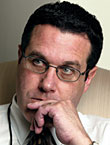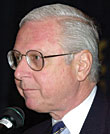INS speeds makeover of visa systems


Connecting state and local government leaders
After the Immigration and Naturalization Service last month sent M-1 student visa forms for terrorists Mohamed Atta and Marwan Al-Shehhi to the Florida flight school where they prepared for the Sept. 11 attacks, howls for investigation and reform echoed anew from the Oval Office and Congress.

Under pressure: Robert Mocny, Entry Exit Program director, says recent events have intensified the scrutiny on INS' information management and helped accelerate plans for upgrading its systems.

INS CIO George Bohlinger told a FOSE 2002 audience that his agency faces challenges such as outdated and stovepiped systems, coordination with other agencies and heavy workloads for field employees.
More cooperation
Some of the systems date back to the 1980s, according to Mocny.
INS has not settled on an architecture for the system, but Mocny said it will likely involve middleware and Web technologies to tie together the databases in which visa, traveler and immigration data is housed. He said interoperability is key, because of the need to share information with other agencies. The goal? 'The right people having the right data at the right time,' he said.
The system will be rolled out in phases. By October, it will compile arrival and departure data for 28 designated low-risk countries'such as Australia, Brunei, Japan and some European nations.
By 2003, the system will capture all alien arrival information at airports and seaports. INS plans to roll out the system at the 50 busiest land border crossings by 2004, and it is to be fully operational at about 300 ports of entry by 2005.
The administration has requested $362 million for the Entry Exit Program for fiscal 2003, Mocny said.
In the meantime, INS will work with the existing patchwork of databases. 'We will use those databases and migrate those databases as necessary,' Mocny said. He conceded that existing data systems likely will continue to permit errors.
'I can't say [mistakes like the Mohamed Atta visa] won't happen again,' Mocny said. 'We don't want to have a society that is so locked down that people can't come in.'
Mocny's candor about the possibility of additional problems in the nation's border control systems was echoed in recent remarks by INS CIO George Bohlinger at the FOSE 2002 trade show.
Bohlinger noted that INS handles a staggering workload'for example, its Border Patrol agents often apprehend 1,500 undocumented border crossers during a busy night in the Nogales, Texas, area alone. He also noted that INS does not issue visas, State does.
But, Bohlinger added, 'The criticism that the systems don't talk to each other is absolutely valid.'
To turn the problem around, INS plans to develop an enterprise architecture for the entry-exit system and all its linked systems. The entry-exit system will be available on the desktops of officials at borders as well as adjudicators and investigators who handle cases.
INS also is probing the use of biometric technology for border control. It already uses a palm recognition system for its INS Passenger Accelerated Service System program, which allows about 20,000 frequent border crossers from the U.S. and low-risk countries who submit to background checks to enter the country more easily.
NEXT STORY: Clarke: IT security is 3 to 5 years away




